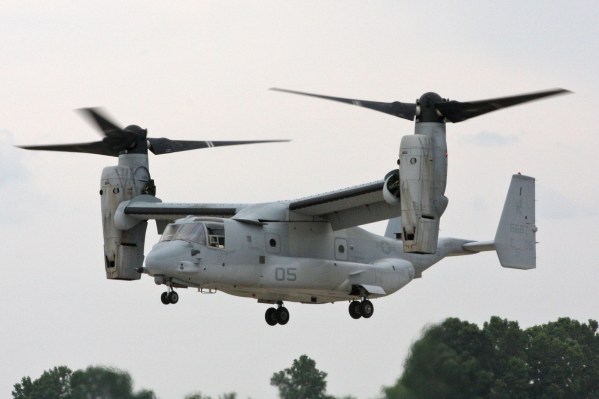Short-haul flights in airborne taxis: It’s next-level alright, but is it next-level hype, or something city-dwellers can actually look forward to? Uber is betting it’s the latter, according to comments made by the company’s head of products to Recode’s Kara Swisher at a conference this past weekend.
Uber’s Jeff Holden said on stage that his company is seriously researching how it might use vertical takeoff and landing (VTOL) aircraft to provide personal transportation service that can literally rise above traffic in cities. And while the idea sounds crazy, Uber’s not the only company enjoying this particular fit of madness: Airbus detailed its own plans to create self-flying taxis earlier this year, and Google’s Larry Page is pitting two startups against each other to create flying cars with VTOL tech via investments in each, to name just a couple of high-profile examples.
Uber’s plan would likely start out with piloted vehicles (like the military V-22 Osprey pictured above), but most VTOL concepts foresee a time when they can be piloted autonomously like many of the rotored commercial drones we see in use today. VTOLs themselves are actually similar to commercial and consumer drones in a number of ways, including their multi-rotor design. Elon Musk is among those think a VTOL could be a great way to bring electric power sources to mass market flight.
Lately, a number of on-demand ride service providers have been expanding the definition of their offerings, via investments in alternate modes of transportation, and partnerships that anticipate different models beyond a simple driver-owned fleet of independent service providers. Lyft’s ambitions extend to a network of vehicles, potentially owned by partners like GM or by Lyft itself, that not only drive themselves, but that can be reconfigured and appointed based on a rider’s needs. You could select a working car, for instance, or something more relaxing or a party vehicle, Lyft co-founder John Zimmer explained in a recent interview.
Holden seems to share a similar vision to Zimmer when it comes to reconfiguring urban spaces, since he told Swisher about envisioning rooftop take-off-and landing spots, and easing traffic in car-clogged San Francisco and Oakland. There are a lot (VERY MANY) things that need to happen between now and a viable, consumer VTOL transportation service, however – and even more to arrive at a future where VTOL pick-ups and drop-offs are handled by self-flying vehicles.
Mostly, the big barriers involve a whole host of regulation, including about vehicles flying in low altitude over urban areas, use of unmanned craft, and use of unmanned craft to transport human beings. Still, Uber is not known for half-heartedly entering into new areas: Its self-driving car initiative went from a partnership with Carnegie Mellon to a fleet of autonomous vehicles in active public trials around 18 months, after all.
